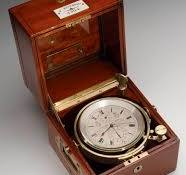Difference between revisions of "Chronometer"
From Bidston Observatory
Jump to navigationJump to search (Created page with " During the latter part of the 19th century, ships' sextants would have been brought to Bidston Observatory for setting accurate Greenwich Mean Time and rating. Rating inclu...") |
|||
| (3 intermediate revisions by the same user not shown) | |||
| Line 1: | Line 1: | ||
| − | + | Also known as '''Marine Chronometer''' | |
| − | During the latter part of the 19th century, ships' | + | <blockquote>This is an example of a marine chronometer, made by Victor Kullberg, which is in the Royal Museums Greenwich. Marine chronometers were used to keep accurate Greenwich mean time at sea. In conjunction with a sextant to observe local noon time, this allowed the determination of longitude (defined relative to the zero longitude at Greenwich). |
| + | |||
| + | During the latter part of the 19th century, ships' chronometers would have been brought to Bidston Observatory for setting accurate Greenwich Mean Time and rating. Rating included checking the temperature response of the chronometer using the 'hotbox' developed by the Obsevatory's Director John Hartnup. | ||
| + | <ref>Bidston Observatory, the Place and the People. Joyce Scoffield. Countyvise limited. 2006</ref></blockquote> | ||
| + | |||
| + | [[File:Victor Kullberg marine chronometer - Royal Museums Greenwich.jpg|400px|Victor Kullberg marine chronometer displayed in Royal Museums Greenwich]] | ||
| + | |||
| + | [[Category:Instruments]] | ||
Latest revision as of 07:42, 9 February 2024
Also known as Marine Chronometer
This is an example of a marine chronometer, made by Victor Kullberg, which is in the Royal Museums Greenwich. Marine chronometers were used to keep accurate Greenwich mean time at sea. In conjunction with a sextant to observe local noon time, this allowed the determination of longitude (defined relative to the zero longitude at Greenwich).
During the latter part of the 19th century, ships' chronometers would have been brought to Bidston Observatory for setting accurate Greenwich Mean Time and rating. Rating included checking the temperature response of the chronometer using the 'hotbox' developed by the Obsevatory's Director John Hartnup.
- ↑ Bidston Observatory, the Place and the People. Joyce Scoffield. Countyvise limited. 2006
